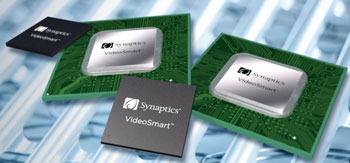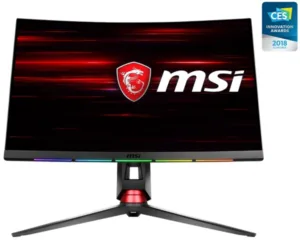Micro-Star International (MSI) showed a range of monitors for gaming at CES under the Optix sub-brand. There are two 27″ curved monitors with 1800R and using VA panels to support 144Hz refresh and 1ms response time. The MPG27CQ supports 2560 x 1440, while the MPG27C is FullHD. Brightness is 250 cd/m² in the lower resolution panel, but 400 cd/m² on the higher one. The new monitors bring the 27″ range to six models and there are also two 24″ units and a 32″ FullHD unit that goes up to 165Hz.
Realfiction, based in Denmark, has been developing a technology for mixed reality that it was showing at CES. The system uses a transparent display, that it calls DeepFrame to overlay images on the background. Fortunately, the company will be at ISE, so we hope to see the company there. The firm told other press that visited in the company’s suite that systems would cost “around $50K to $60k” for the initial screen, which has a 64″ diagonal. The image is said to be created on a ‘4K curved OLED’ and then projected onto the panel. The company has previously supplied 10,000 of its Dreamoc pyramid ‘mixed reality’ displays to high end retailers.

Samsung has posted a video that shows the work that was taken in setting up the company’s booth at CES, which used a 32m x 7.8m display using 4926 480 x 65mm modules. The company said that the displays are the first HDR LEDs using P1.5, P2.0 and P2.5 units. Work started on December 26th and the display was controlled by Samsung’s own MagicInfo software.
Synaptics showed us its touch solutions at CES (MDM Round Up CES 2018), but had a separate area for the SoCs that it is now supplying, since it took over the Marvell Multimedia Solutions business in September 2017. At the show, the company was showing the VideoSmart BG5CT which is pin-compatible with the previous BG4CT Android TV SoC but which adds HDR and higher performance. The chip has a 1.6 GHz 15K DMIPs
Quad Core ARM CPU, a 2.8 GPixel per second GPU, ‘carrier-grade’ security, and what is claimed to be ‘state-of-the-art’ power management techniques, all designed for Pay TV operators and set-top-box manufacturers. The chip has the Qdeo video processing and will support both Dolby Vision and Technicolor HDR and also offers up-conversion.

Analyst Comment
Comment (INITIALS)

